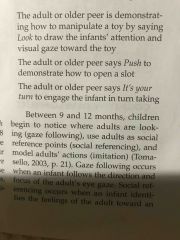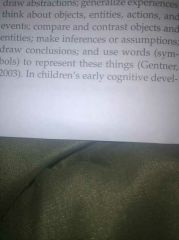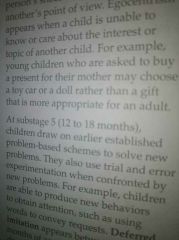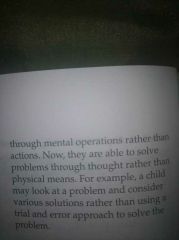![]()
![]()
![]()
Use LEFT and RIGHT arrow keys to navigate between flashcards;
Use UP and DOWN arrow keys to flip the card;
H to show hint;
A reads text to speech;
120 Cards in this Set
- Front
- Back
- 3rd side (hint)
|
The innate tool infants possess that equips them for language acquisition and interaction with people: |
Perceptual preferences |
|
|
|
An example of perceptual preference is: |
A 2 month old prefering to gaze at a human face vs. at an inanimate object. A 2 month old imitating a human facial gesture but not of an object imitating human movement. |
|
|
|
True or False: The examination of infants' perception tells us a great deal about the human mind. |
True. |
|
|
|
Multiple choice: In imitating an adult's reaction of facial expression, will a 6-12 month old infant prefer to choose an object that had a negative reaction or positive reaction? |
Positive. |
|
|
|
The ability of infants to interpret facial expressions and thus be able to read another person's feelings and thoughts is a sign of a developing, albeit primitive, ______________________. |
Theory of Mind (TOM) |
|
|
|
At what age to infants engage in vocal turn taking in response to sounds produced by adults? |
3 months |
|
|
|
During which months can an infant detect intonational changes in speech patterns? |
Between 1 and 4 months. |
|
|
|
By what month can an infants begin to imitate some sounds? |
5 months. |
|
|
|
At 5 months, what can be confusing to an infant in regard to hearing their name being called? |
They confuse their names with words that have the same amount of syllables ex. Missa and Monkey. |
|
|
|
At what month do infants respond to their names? |
5 months |
|
|
|
Fill in : Between (a)___&(b)___ months, infants recognize their own (c)_____difder from other nonsicial stimuli, such as, for example (d)_____s &(e) _____s. |
A.5 B. 8 C. Voices D. Whistles E. Horns |
|
|
|
At 6 months of age, infants become more sensitive to changes in between ______. |
Sounds.
|
Ex. They react to /b, d, g/ (stop-stop-stop) followed by a series of nasal sounds /m, n, ng/
This reaction/understsndibg provides support for understanding differences between words (ex. Bud vs Mud). |
|
|
There is one study that found that 7-month old infants had a preference for a _____that contains a ____that they previously had heard in isolation.
Preference is expressed by infant's_____. This suggests an innate ability for learning ______s. |
Sentence Word
Greater response/reaction. Words. |
|
|
|
Are infants able to perceive sound differences that are absent from their own native language? |
Yes. |
|
|
|
By 18 to 20 months, infants recognize the connection between _______movements and _______connected with these movements. |
Mouth Sounds |
|
|
|
Between ___and ___months, children listen when spoken to, recognize words for common objects present in their environment, and respond to simple requets. |
7 12 |
|
|
|
What are 3 examples of Reflexive sounds and when do they appear? |
Burping Crying Laughter At about 2 months. |
|
|
|
Infants engage in turn taking (with syllables, of syllables ex. Bah) in interaction with adults at ____months. |
3 |
|
|
|
Imitation for production of sounds such as "ah" and "oh" appears at ___months. |
5 |
|
|
|
What is the earliest form of infant vocalization? |
Crying |
|
|
|
Cooing beflgins at ____month. |
1 |
|
|
|
At what month do infants add consanents to their cooing? Ex. Mamama..consonant-vowel condos marking onset of are duplicated babble |
3 to 4 months. |
|
|
|
_________ ________ is defined as the production of duplicated syllable sequence. |
Reduplicated babbling |
|
|
|
During which months should are reduplicated babbling appear? |
6 to 7 months |
|
|
|
'Bababababa' is an example of _________ ________. |
Reduplicated babbling. |
|
|
|
What is Variegated babbling characterized by? |
By varied consonants and/ or vowels in syllable sequences. |
|
|
|
"Babibuga" localized by an 8 or 9 month old is an example of: |
Variegated babbling. |
|
|
|
What does PCF stand for? |
Phonetically consistent forms (PCFs) |
|
|
|
2 words which mean the same thing as PCF (theoretically consistent form): |
1. Vocables 2. Performatives |
|
|
|
Do PCFs appear in infant's early production before or after their first words? |
Before. |
|
|
|
What does PCF/vocables/performatives refer to? |
A consistent relation between an infant's production and a particular thing. |
|
|
|
Scenario: a child produces "ah" to mean "pick me up" or "oh" to mean "I want a bottle". These are both examples of: |
Phonetically Consistent Forms |
|
|
|
PCF's mark the beginning of ________ communication. |
Meaningful |
|
|
|
What is Jargon? |
Nonsense syllables produced by children. These syllables : ~appear to mirror real words (ex. Such as "Wada ja noba ga?) ~have intonational patterns of adult language (ex. Such as the international pattern of questions or statements). |
|
|
|
When does Jargon appear? |
At 9-12 months |
|
|
|
When do actual WORDS first appear? |
At 12 months. |
|
|
|
What kind of words are the first to be produced y 12-month-olds (or whenever first words are produced)? |
Words that identify familiar entities. |
|
|
|
What are some examples of FIRST WORDS a child will produce and why specifically these? |
Mommy, doggie, birdie, cribbie, cookie, car, shoe.
Specifically these because they are familiar identities and objects. |
|
|
|
Vocalization of child when beginning to produce words: "Dawa go?". This shows that _____may also appear in children's productions when they begin to produce real words. |
Jargon |
|
|
|
Examples of Patent and Child Interaction which ensure the child is able to compregend spoken language: |
The adult's interaction will be characterized by: ~production of shorter sentences ~simplified syntactic structure ~slowed speech rate ~pauses between separate utterances ~a greater number of prompts (questions and commands).
|
|
|
|
True or false: Parent-to-child interaction plays a role in children's language development. |
True. |
|
|
|
Multiple choice: A child says "I eated a cookie" and the adult models to the child that "I ate" in order to provide the child with a word absent from his/her vocabulary. This is an example of : A. Joint attention B. Scaffolding C. Infant perception D. Recasting E. B and D |
E |
|
|
|
When children acquire words by overhearing conversations or listening to stories, they acquiring words through: _________ learning. |
Incidental |
|
|
|
True or false:
Children do not rely on contextual information to learn the meaning and use of these new words independently. 3 |
False |
|
|
|
A child listens in to a conversation about baking a cake. (Flour, mix, beat eggs). Later he will use these words to apply to new contexts, such as baking a cookie. Is this an example of incidental learning? |
Yes. |
|
|
|
3 factors in Adult speech which influence receptive and expressive language in children: |
1. Number of words 2. Frequency of words 3. Diversity of words |
|
|
|
True or false: There is a innate presence of cognitive s in children as well as an influential factor of environment affecting language acquisition in children. |
True. |
|
|
|
What forms are a child’s first words (12 months- objects and loving identities) made of? Later productions are in form of: |
CV (go) or VC (up)
CVC (ex. Cup) |
|
|
|
What are phonemic representations? |
Words produced in a manner consistent with adult targets. |
|
|
|
Are children’s early words always accurate phonemic representations? |
No. |
|
|
|
Give an example of inaccurate phonemic representation: |
Target word: baby Attempts of child consist of bih or bihbi, along with correct target word baby. |
|
|
|
At what # of words acquired do children’s production accuracy increase? |
150 to 200. |
|
|
|
How many word utterances can an 18 month old produce? |
2 word utterances. |
|
|
|
By age 3, children use language to communicate their _________, _______ and _______with greater accuracy. |
Feelings Observations Needs |
|
|
|
What is it called when the infant and another person share their direction of eye gaze? |
Joint attention |
|
|
|
What is it called when the infant and adult share an action on the same object or task? |
Joint action |
|
|
|
What is the most significant feature of joint attention and joint action? |
Children’s first word productions appear in these contexts. |
|
|
|
Multiple choice: The correlation between the amount of time spent on joint attention tasks and the infant’s vocabulary is: A. Low B. High C. Moderate D. Nonexistent Why? |
B. Because joint attention events supply the infant with information on the adult’s actions and language associated with these actions. |
|
|

This is an example of: |
Joint interaction. |
|
|
|
Between 9 and 12 months children begin to notice where adults are looking. This otherwise knows as _______ ________ing. |
Gaze following |
|
|
|
A cold using an adult as as a social reference point (9-12 months) is known as: |
Social referencing. |
|
|
|
A child modeling an adult’s actions begins between__ and __ months and is called ______. |
9 12 Imitation |
|
|
|
When a child identifies the feelings of of an adult toward an object and later uses this information for his or her own feelings toward the object, ______ ______ing is occurring. |
Social referencing |
|
|
|
Is an infants ability to understand an adult's perspective (visual focus) an essential component in language development? |
Yes. |
|
|

The following fall under the roof of:___________. The mental ability to...(continue by reading image). |
Cognition |
|
|
|
Psychological structures which allow children to process information and organize knowledge about the world are called: ____________. |
Schemas |
|
|
|
True or false : Schemas prevent children with the ability to construct a representation of entities and events that appear around them. |
False. Schemas actually provide them with this ability. |
|
|
|
Name the process for changing a schema in response to a new entity: |
Adaptation |
|
|
|
Name the cognitive process of that involves fitting the newly adapted entity into the existing schema:________. |
Assimilation |
|
|
|
Changing an existing schema to make the new entity fit is called _________. |
Accommodation |
|
|
|
Cognitive balance is called e______m. |
Equilibrium. |
|
|
|
Through which 2 processes is equilibrium achieved? |
Assimilation and accommodation. |
|
|
|
What is the first stage of cognitive development? |
The sensorimotor stage |
|
|
|
What is means-end behavior ? |
When a child establishes a method to obtain a goal. |
|
|
|
What is object constancy ? |
The understanding that an object remains the same even when it us viewed from a different perspective such as upside down or empty. |
|
|
|
What is the word used to describe "actions having a cause": |
Causality |
|
|
|
What is object permanence ? |
When children possess the memory that an object exists when it is absent from their sight. |
|
|
|
The inability of a child to step into another's shoes or see things from another's point of view is called ________. |
Egocentrism. |
|
|

The example of young child buying gift is an example demonstrating _________ism. |
Egocentrism. |
|
|
|
How many substances of the sensorimotor stafe of cognitive development are there ? |
6 |
|
|
|
What is deferred imitation? When does this appear? |
When children observe an activity, establish this action in their memory, and imitate the action at a later time.
Between 12 and 18 months. |
|
|
|
Symbolic functions appear with the production of first eords, when words are used to ________an entity or activity. What is an example? |
Represent. Ex. DOG to represent the thing that is furry, has 4 legs, and barks. |
|
|
|
Referent present refers to :(a) Referent absent refers to :(b) |
A. Child produces first word and entity (ex. Dog) is present. B. When children achieve genuine symbolic knowledge when using the word when the entity is not present. In the case of B, children have established an internal representation of this entity and use a word to represent it. |
|
|
|
Between 18 and 24 months, representational thpughts appear. This means : |

Children understand the world through mental operations rather than actions.
|
|
|
|
The preoperational stage last from what to what year? |
2 to 6 |
|
|
|
What'd Is decontextualization? Give an example that would show a child's ability to we decontextualize: |
To separate an inject from its immediate context.
Ex. A child uses a block to represent a phone and uses words to represent a thing, even when the thing (block) us not the thing itself (phone). |
|
|
|
The first stage of pretend play involves using child's own daily activities, the second is others activities (such as dolls, play mommy/house). This second stage reflects_________which is the ability to consider others roles in the play scheme. |
Decentration. |
|
|
|
A |
B |
|
|
|
Give an example of a means-end skill carried out: |
Pulling a strung or a blanket to bring a toy closer. |
|
|
|
What is Autosymbolic Play? Give an ex. |
Play involving activities that represent their own daily activities Ex. Pretenfing to sleep/drinking from a cup |
|
|
|
At what age should most phonological processes disappear ? |
Age 3. (Or 3.5) |
|
|
|
MLU stands for: |
Mean length of utterance |
|
|
|
How is the MLU calculated? |
By counting the number of morphemes in each utterance produced, usually assessing at least 50 to 100 separate utterances. We then divide the number of morphemes by the number of utterances. |
|
|
|
Review the following pages in book, cards got deleted: |
114 to 119 |
|
|
|
What is the importance of understanding morphological differences? |
So one understands that this and others language differences do not signal a disorder. |
|
|
|
What is a alternative mean to assess a child for language skills given the morphological differences among languages? |
Nonword or novel word repetition, as it has been found to correlate with language impairment in children who are learning English as their second language.
There is considerable evidence that children with language impairments have difficulties with nonword repetition tasks, for both English and Spanish/English speaking children. Wha |
|
|
|
What is morphonology? |
The connection between morphemes and phonology. |
|
|
|
Syntax describes rules for producing ________s through the combination of ________s. Show an example. |
Sentences Words Ex. The+apple+is+on+the+table. |
|
|
|
When does syntax emerge? |
When. Children begin to produce 2 word utterances, at about 18 months of age. |
|
|
|
1. The first 2 word utterances of children at 18 months of age (ie. Syntax) are utterances that indicate ______ and ______ of the world. 2. Give a possible example. 3. What basic components are these composed of?
|
1. Requests and Observations 2. Ex. Pick up/see doggy/push ball/wanna snack/daddy go. 3. Noun phrases and verb phrases.
|
|
|
|
Nouns label _________s. |
Entities |
|
|
|
A. Verbs label ______s. B. Mental verbs refer to _________. |
A. Actions. B. A person’s mental state. |
|
|
|
What is subject drop? Give an example. |
Before age 2 1/2 when children’s utterances increase in length, it is very common for children to omit the subject in a noun phrase. Ex. Want cookie. (Syntactic rules state that noun phrase must contain a noun and verb phrase must contain a verb) |
|
|
|
Perspective taking involves understanding that ____________________. What challenge may this bring up in the language acquisition of a child? |
The point of view of others differ from the child’s own.
Confusion of pronouns such as you/I/me etc. |
|
|
|
Which of the following two sets of pronouns emerges earlier? A. Referring to self(I/my/mine/me) B. Referring to others (he/she/they) |
Choice A does. |
|
|
|
Which of the following do children learn first? A. Possessive pronouns (his/hers/theirs) B. Objective pronouns (him/her/them) |
B |
|
|
|
Which are the last type of pronouns to be acquired and at wants age are they generally acquired? |
Reflexive pronouns (himself/herself/ourselves). Age 5 years. |
|
|
|
______s offer less conceptual complexity than verbs. |
Nouns |
|
|
|
Verbs convey the meaning of ________. |
Events. |
|
|
|
What is mutual exclusivity bias in reference to children’s word learning? |
When children are presented with a new word, they gaze at the only object for which they lack a name. Children use this strategy until 17 to 22 months of age, holding on to the principal that each referent can only have one name. |
|
|
|
What is mutual exclusivity bias in reference to children’s word learning? |
When children are presented with a new word, they gaze at the only object for which they lack a name. Children use this strategy until 17 to 22 months of age, holding on to the principal that each referent can only have one name. |
|
|
|
Eat. Read. Do. Fix. Put. Go. Sit. Want. Have. Know.
These are all examples of what? |
The first verbs produced by young children, all describing simple actions and used in the context where they we’re initially acquired. |
|
|
|
What is mutual exclusivity bias in reference to children’s word learning? |
When children are presented with a new word, they gaze at the only object for which they lack a name. Children use this strategy until 17 to 22 months of age, holding on to the principal that each referent can only have one name. |
|
|
|
Eat. Read. Do. Fix. Put. Go. Sit. Want. Have. Know.
These are all examples of what? |
The first verbs produced by young children, all describing simple actions and used in the context where they we’re initially acquired. |
|
|
|
What is the difference between a transitive and intransitive clause. Which one appears first and why. |
Transitive=subject+verb+object Intransitive=subject+verb The intransitive appear first as there is less complexity in their construction. |
|
|
|
When achild uses the regular past tense verb form to produce an irregular verb, he is ___________ing. This shows the interaction between ________logy and _______production. |
Overgeneralizing Phonology Verb (Ex. I eated it/I throwed the ball/I goed there) |
|
|
|
What change takes place in the following irregular verbs? A. Cut/cut B. Come/came C. Stand/stood D. Sweep/swept E. Build/built |
A. No change B. Internal vowel change C. Internal vowel change with unchanged final dental consonant D. Internal vowel change with final change E. Final consonant change from /d/ to /t/ |
|
|
|
What change takes place in the following irregular verbs? A. Cut/cut B. Come/came C. Stand/stood D. Sweep/swept E. Build/built
Which attracts no overgeneralization? Which attracts it? |
A. No change B. Internal vowel change C. Internal vowel change with unchanged final dental consonant D. Internal vowel change with final change E. Final consonant change from /d/ to /t/ -A does not attract it, the rest are most likely to. |
|
|
|
What is another term used for “helping verbs”? What are examples? They are used in conjunction with main________s to express ______or ______.
|
Auxiliary verbs Am. Is. Are. Was. Were. Been. Verbs Time Tense |
|
|
|
Auxiliary ________verbs are will/shall/may/might/can/could/must/ought to/should/would/used to/need to. What are these used to express? |
Modal. To express certain attitudes such as disapproval, possibility, or ability. |
|

